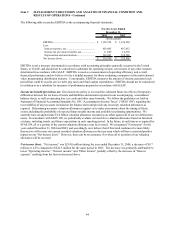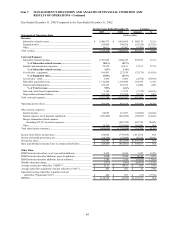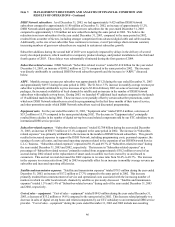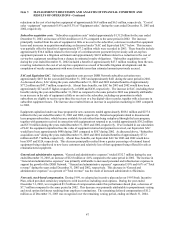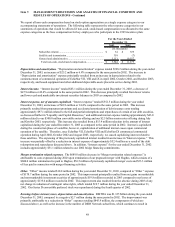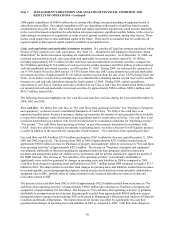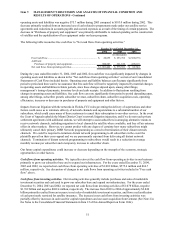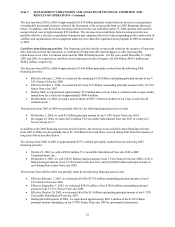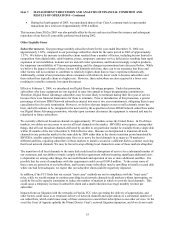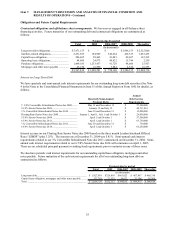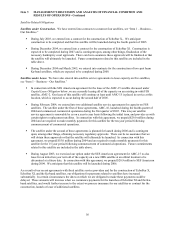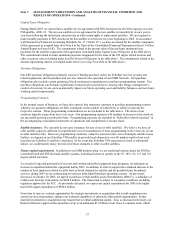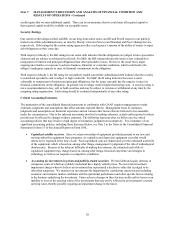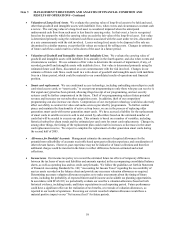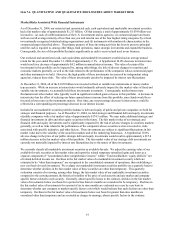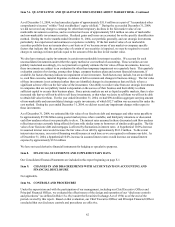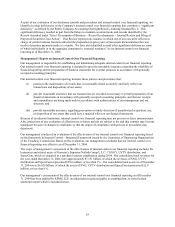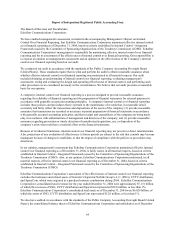Dish Network 2004 Annual Report Download - page 62
Download and view the complete annual report
Please find page 62 of the 2004 Dish Network annual report below. You can navigate through the pages in the report by either clicking on the pages listed below, or by using the keyword search tool below to find specific information within the annual report.Item 7. MANAGEMENT’S DISCUSSION AND ANALYSIS OF FINANCIAL CONDITION AND
RESULTS OF OPERATIONS - Continued
54
private settlement agreements with additional stations, we will attempt to assist subscribers in arranging alternative
means to receive network channels, including migration to local channels by satellite where available, and free off
air antenna offers in other markets. However, we cannot predict how many subscribers might ultimately cancel their
primary DISH Network programming as a result of termination of their distant network channels. We could be
required to terminate distant network programming to all subscribers in the event the plaintiffs prevail on their cross-
appeal and we are permanently enjoined from delivering all distant network channels. Termination of distant
network programming to subscribers would result in a reduction in average monthly revenue per subscriber and a
temporary increase in subscriber churn.
Increases in piracy or theft of our signal, or our competitors’ signals, also could cause subscriber churn to increase in
future periods. We continue to respond to compromises of our encryption system with security measures intended
to make signal theft of our programming more difficult. In order to combat piracy and maintain the functionality of
active set-top boxes, we are in the process of replacing older generation smart cards with newer generation smart
cards. We expect to complete the replacement of older generation smart cards during the second half of 2005.
However, there can be no assurance that these security measures or any future security measures we may implement
will be effective in reducing piracy of our programming signals.
Additionally, as the size of our subscriber base continues to increase, even if percentage subscriber churn remains
constant, increasing numbers of gross new DISH Network subscribers are required to sustain net subscriber growth.
Subscriber acquisition and retention costs. As previously described, we generally subsidize installation and all or a
portion of the cost of EchoStar receiver systems in order to attract new DISH Network subscribers. Our costs to
acquire subscribers, and to a lesser extent our subscriber retention costs, can vary significantly from period to period
and can cause material variability to our net income (loss) and free cash flow. While there can be no assurance, we
believe continued tightening of credit requirements, together with promotions tailored towards subscribers with
multiple receivers and advanced products such as digital video recorders and high definition receivers, will attract
better long-term subscribers. Our “Subscriber acquisition costs,” both in the aggregate and on a per new subscriber
activation basis, or SAC, may materially increase in the future to the extent that we introduce other more aggressive
promotions if we determine that they are necessary to respond to competition, or for other reasons.
Our equipment lease penetration increased during the year ended December 31, 2004 as compared to the same period
in 2003. This reduced our “Subscriber acquisition costs” and SAC for the current period, and resulted in an increase
in capital expenditures. In the event we continue to increase our equipment lease penetration, our SAC will continue to
be positively impacted and our capital expenditures will continue to increase. Although we believe these increases in
capital expenditures have been, and will continue to be, mitigated by equipment returned from disconnected customers
that has been or will be redeployed, new compression technologies will inevitably render some portion of our current
and future EchoStar receivers obsolete, and we will incur additional costs, which may be substantial, to upgrade or
replace these set-top boxes.
In an effort to reduce subscriber turnover, we offer various programs to existing subscribers including programs for
new and upgraded equipment. We generally subsidize installation and all or a portion of the cost of EchoStar
receivers pursuant to our subscriber retention programs. During the second half of 2004, we expanded our retention
program by offering to lease additional receivers to existing subscribers. Our capital expenditures related to
subscriber retention programs could increase in the future to the extent we increase penetration of our existing
subscriber equipment lease program.
Cash necessary to fund retention programs and total subscriber acquisition costs are expected to be satisfied from
existing cash and marketable investment securities balances and cash generated from operations to the extent available.
We may, however, decide to raise additional capital in the future to meet these requirements. If we decided to raise
capital today, a variety of debt and equity funding sources would likely be available to us. However, there can be no
assurance that additional financing will be available on acceptable terms, or at all, if needed in the future.


